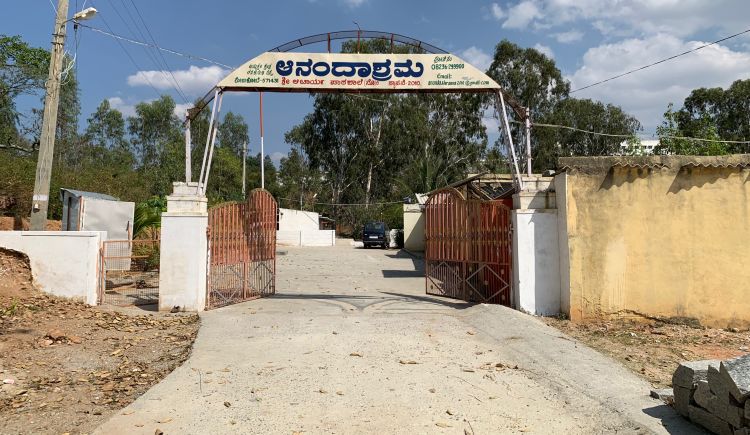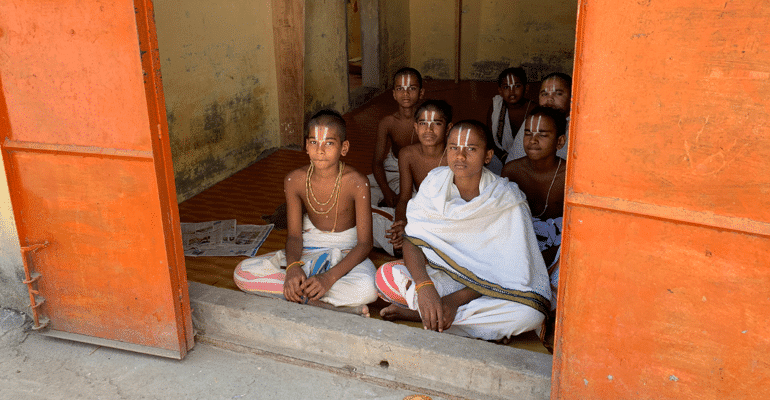Some of us cannot talk about Sanskrit without going back to good old school days, especially those who had Sanskrit as their optional language! The struggles and countless practices, to memorize the shlokas and dhatu (verbs) in Sanskrit, to get the translations and spellings right on exam sheets, has a space of its own in our memory palate. But, we failed to understand one very significant thing- we learned the language because we had to, not because we wanted to.
This 3200 to 3500-year-old language is not just mere words, but the powerhouse of wisdom- probably the oldest language, which is said to have given birth to several other languages and contributed to Latin and Greek. Take any ancient texts- be it Vedas, Upanishads, Epics like Mahabharata and Ramayana- all of them are scripted in Sanskrit.
Life Beyond Numbers spoke to Vijayaraghavan Vinjimur Vasudevan, a 27-year-old software engineer, who is on a mission to revive the only functioning Sanskrit school, Anandashram, in Melukote.
Click here to support and join his mission.

Vijayaraghavan who hails from Chennai’s Triplicane mentions that even 2 decades back, there were at least 20 Sanskrit schools, but by 2008, the number of schools started to diminish and soon none was left. “My grand-uncle went to a Sanskrit school and he used to recite shlokas. As I started growing up, I was completely fascinated by this language and wanted to learn it. It was only a few years back, I was not searching for disappearing Sanskrit schools, but looking for a way to learn devotional shlokas and then when Anandashram, a Sanskrit school in Melukote caught my attention,” he says.
So, what’s the story of Anandashram?
Once known to be a home of Sanskrit studies, Melukote, which is considered as one of the most sacred places in Karnataka had about 15-20 schools that taught this language and followed the ancient Gurukul style of the education system. It was the Nalanda and Takshasila of the south and students from all over India used to flock here to increase their wisdom and gain knowledge from Saints.
It is said that the great Sri Vaishnava Saint, Sri Ramanujar, who had stayed here for some time as no practicing Sri Vaishnavite could tolerate the tortures of Kulothunga Chola II AKA Kirumi Kanda Cholan.
Anandashram, the Sanskrit school in Melukote is started by Sri Paramahamsa Ithyadi Satagopa Ramanuja Jeeyar, the 23rd Peetathipathi of Sri Manavala Mamuni Mutt, Srivilliputhur, who once visited the region for Vairamudi Sevai.
It was then, the devotees and disciples of the hut (maTha in Sanskrit) who urged him to open a School in Melukote. Jeeyar Swami agreed to their request and started taking Sanskrit classes in a rented house. Attending these classes also had an advantage for it was absolutely free of cost for students– be it books, uniforms, shelter or food, all is taken care of by Jeeyar Swami.
Because of the Gurukulam style of education, in this school, the students are expected to follow the tradition of performing certain rites along with studies- Nithyakarma.
At the inception of the school, Jeeyar Swami had no money to provide daily meals to children. The condition of the hut was also precarious. Even though there were financial issues, Jeeyar Swami possesses divine grace and enough wisdom to guide the students.

To arrange daily meals for the students, he used to go begging for food and borrowed from ration shops. When the disciples of the hut came to know of this, they started donating whatever they had so that the school runs smoothly. But, over a period of time, the expenses started rising and regular donations stopped coming in.
Sanskrit – A vast repository of wisdom
Not only Dr.Ambedkar was a signatory to the draft amendment motion to declare Sanskrit as India’s official language, but Swami Vivekananda and Mahatma Gandhi have also emphasized on the need to learn the language because of its usefulness.
“Children should learn the language completely out of love, not because they have to, else they will never experience the essence of learning this ancient language,” says Vijayaraghavan.
Recalling the teachings of his Guru, he says, in the ancient text of Purushasuktam, it is mentioned-
brāhmaṇo’sya mukham-āsīd bāhū rājanyaḥ kṛtaḥ |
ūrū tad-asya yad vaiśyaḥ padbhyāgṃ śūdro ajāyata ||
Meaning– The ‘brāhmaṇa’ was His (God) mouth, the ‘kṣatriya’ was made of His two arms, then His two thighs became the ‘vaiśya’, from His feet the ‘śūdra’ was born.

“I believe, if we see the world with tinted glass, it will always appear black. So, we have to see the world with clear eyes, without any prejudice. The text doesn’t promote the idea of discrimination or oppression against any particular caste, but that God is the best form of everyone and belongs to all,” Vijayaraghavan adds.
How you can help to save and revive this dying language
From 7-10-year-olds, today the school is comprised of about 18 registered students and 6 teachers. Even though Sanskrit is given utmost importance in this school, proper school education is also provided here and it is affiliated with Karnataka board and is recognized by Bangalore University as well.
Vijayaraghavan says, “The first batch of students from this school has scored really well, with an average of 80%. The teachers are making sure that they excel academically in case they want to pursue higher studies in other subjects.”

“The problem is that people take pride in saying that they don’t know their culture or native language. I feel, knowing our roots are very important. Forget about language, people now use emojis to communicate. Are we progressing or regressing?” asks Vijayaraghavan.
But, now the School is in a dire shortage of funds and has not been paying the teacher’s salary for the past year. The buildings also need attention. Any help in the form of donation at this point of time will be helpful in the education of these students who are currently enrolled with the institution.

